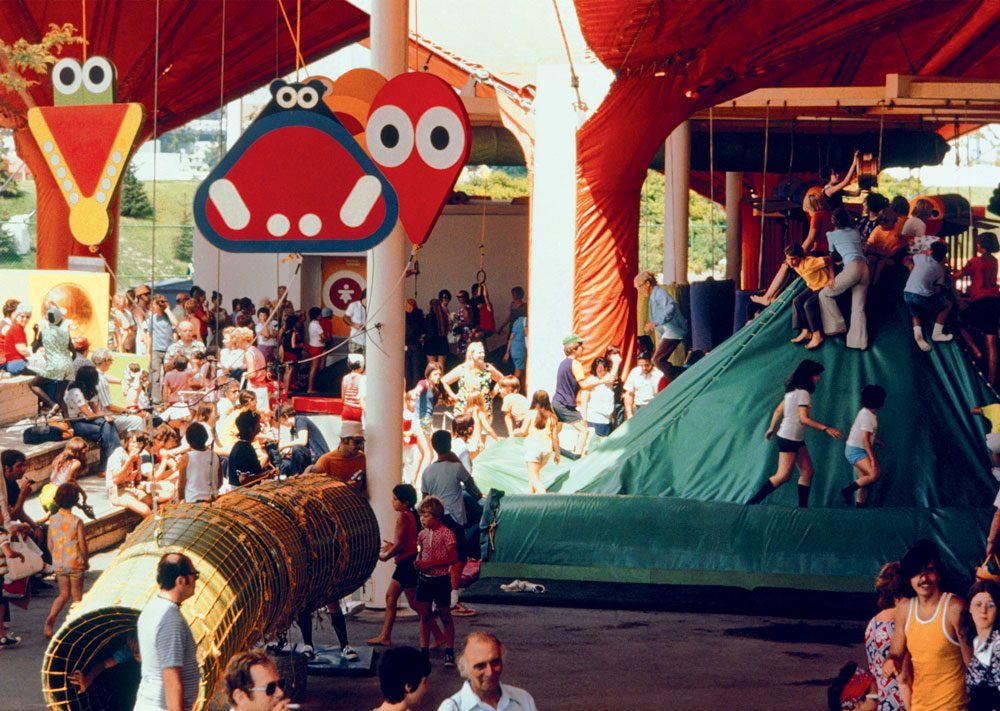How One Ontario Playground Reinvented the Way Kids Have Fun
When it opened in 1972, there was nothing quite like it. How Children's Village at Toronto's Ontario Place changed the modern playground.

Play time
The greatest playground in Canadian history was built as an afterthought. In spring 1971, Ontario Place opened with all the fanfare and anxiety that attends the launch of any large-scale development in Toronto. Sparked by the success of Montreal’s Expo 67, the massive waterfront project was conjured out of a mixture of large-scale optimism and small-minded jealousy. The park’s somewhat unpromising theme: the glorious past and thrilling future of the province of Ontario.
During that opening season, visitors were awed by the IMAX movies, the open-air Forum theatre and the park’s self-flushing toilets. They ogled architect Eberhard Zeidler’s series of man-made islands and “pods,” which stuck out of the water, skewered by columns. But one oversight quickly became clear: there wasn’t enough for kids to do. When the park decided to build an area devoted to children for the following year, park director Jim Ramsay turned to design consultant Eric McMillan.
McMillan was a lanky, wild-eyed, 30-year-old Englishman with the accent and mannerisms of one of Monty Python’s more unhinged characters. He had designed Ontario Place’s most successful exhibition that year, a multimedia tour through the province’s history, but he’d never built anything for children. During a meeting with Ramsay, McMillan remembers his boss asking for his opinion on the park. McMillan didn’t hesitate. “I think it’s boring,” he said. “Well, what would you do?” asked Ramsay. “I don’t know,” said McMillan. “Give me two weeks.”
McMillan huddled with his assistant David Lloyd, and when they returned it was with a series of sketches for a playscape unlike any seen before, in Toronto or any other city—a colour-blocked kingdom of hanging punching bags, vinyl-clad foam mountains and soaring climbing nets. Children’s Village would be a massive success. It would launch McMillan’s career. It would sit at the centre of kid life for a generation of Torontonians and, briefly, promise to revolutionize the way we play.
All in your imagination
The playground is a curious creation. The first one in North America was a simple pile of sand in Boston’s north end, installed in 1885 by female philanthropists who wanted to give poor immigrant children a place to play and, crucially, a means to assimilate into American society. That push and pull, between providing children with autonomy and controlling them, has been at the heart of playground design ever since. They’re places to expand children’s imaginations while constraining their bodies. “Playgrounds are places made by adults, for children, always with the hope of harnessing their play to a specific location,” writes architecture critic Alexandra Lange in her book The Design of Childhood.
In theme parks, where the prerequisites of play meet the demands of capitalism, the balance between controlling a child’s behaviour and stimulating their creativity becomes more wobbly. Parks in the Disneyland mould are, above all, about managing the play of children, moving them along efficiently, safely and profitably. The equipment is to be used in a specific way, with no latitude for experimentation. The modern theme park seems to offer boundless creativity to its designers while leaving little scope for the children themselves.
McMillan wasn’t interested in controlling kids. In designing Children’s Village, his driving philosophy was simple: “What would I, as a child, like to do?” It’s an interesting question for someone whose childhood was full of Dickensian deprivation and casual violence. McMillan’s biography—a mixture of fact and family mythology that is difficult to untangle—was that he was stillborn during the bombing of Sheffield during WWII, revived by a nurse, and from there life only got harder. “Lots of violence,” he says, “lots of drinking, lots of poverty.”
As a kid, McMillan was often hungry and nearly always dirty. For a time, his family lived in the shadow of the Manchester prison then called Strangeways. They were desperate enough that, one cold winter, his uncle and father broke into the prison to steal coal. He was constantly moving from rooming house to rooming house, school to school. His father was a day labourer, when he had work. On weekends, he would put on his one good suit and play piano in local pubs, earning as much in a single night as he would in a week, before drinking it all away.
The flip side of a childhood of neglect is absolute freedom. “My early memories were just being like a dog, let out in the mornings and let in at night,” says McMillan. In those early years, he would play in the rubble of bombed-out buildings, clambering over the ruins, playing violent games with bricks, building paper airplanes out of the pages of discarded books. There were no restraints, no control.
When he left school at 15, he could barely read or write. He got a job as a painter’s apprentice and prepared for a life as a labourer. The trade school was attached to an art school, however, and as he slowly began to talk with the neighbouring students, the idea of applying there himself became fixed in his mind. He took the exams, got in, and immediately entered a new world. He graduated a few years later, with growing confidence and an enormous chip on his shoulder. After designing museum exhibitions in England, he saw ads looking for a designer for Expo 67 and made his way across the Atlantic.
At one point, McMillan’s personal website included the story of how he escaped his upbringing. He told the story with a characteristic mix of arrogance and deadpan understatement: “I became an apprentice house painter and then moved up to art school, and then I became a genius and moved to North America.”
Mastermind
I’ve known Eric McMillan since I was a child. My father, another English immigrant who found himself in Canada in the 1970s, was also on the original Ontario Place team, as an editor on the park’s first IMAX film, and the two quickly became friends. As a kid, I remember McMillan striding into our house—a wild presence, all jutting elbows and knees, who would appear out of nowhere with a trunk full of plastic balls or a truckload of couch-sized interlocking plastic blocks, prototypes for a new experiment in fort-building.
At Children’s Village, he was given free rein and a $700,000 budget—or about $4.5 million in today’s dollars. The time in which he was working was a remarkably fertile one for children’s design. In the postwar era, with the baby boom, there were suddenly brand new economies around childhood. With government and institutional support, designers felt free to experiment. “People at the highest echelon of design were interested in childhood,” says Lange. “It wasn’t a subset; it was at the centre of design.”
This was the era in which “junk playgrounds” or “adventure playgrounds”—places where tiny children were given tool belts and a fistful of nails and left to build their own forts—proliferated across the continent, including one at the foot of Bathurst Street in Toronto. It was an era in which designers emerging from the ’60s, full of dreams about building political and social utopias, took their visions to the local parks, building abstract sculptures and modernist experiments that children could clamber over.
At Children’s Village, McMillan created a hectare of mayhem under an orange canopy—reproducing his feral childhood scrabbling through rubble in the safety of Toronto, with mountains of colourful vinyl and foam. He erected an enormous spiderweb structure made out of rope that hung from soaring watchtowers. He built a series of wooden ladders that spun on their axes, hurling would-be climbers to the mats below. He strung swinging monkey bars over a pool of water and suspended a forest of punching bags at the centre of the village that was, for decades, the most reliable producer of bloody noses in Toronto.
In my memory, the overriding feeling of entering Children’s Village was of an exhilarating, perhaps even slightly scary freedom. The world under the iconic orange canopy was capacious enough that you always felt as if there were undiscovered corners—a kid-sized hamster wheel beneath a small hill, a new rope bridge from one of the watchtowers you’d never taken. Here, at last, was a place that had been built specifically for you and then left to your dominion. There were no parents to help you in the chaos. Exactly how you chose to scramble your brain flinging yourself between the giant vertical rubber bands was your business. The place was yours. It was your village.
Children’s Village was a hit. Families flocked to it, and international media praised it. McMillan remembers Time calling it “one of the most imaginative playgrounds in the world.” The next year, the Ontario Place brass gave McMillan control over another section of the park, and he set to work creating a water play area. It included lagoons and climbing equipment amid rushing water, enormous squirting faces controlled by pumps and bicycle-powered water guns.
Built before the first water parks or splash pads, McMillan’s attractions were created from scratch, gathering a team of prop builders, metal workers and craftsmen who could manufacture his dreams. One of the early visitors to McMillan’s park was an American named George Millay. Today Millay is credited as the father of the water park, the progenitor of a massive industry. When Millay opened the first Wet ’n Wild in Orlando in 1977, however, the name he gave the children’s area was a tip of the cap to his inspiration: Canadian Water Caper.
With his success at Ontario Place, McMillan became a major figure in the blossoming world of children’s design. “Suddenly I became the world’s expert on child’s play,” says McMillan. People began calling him the next Walt Disney. Over the next decade he designed playgrounds in various SeaWorlds in America and amusement parks in France. He built a park in a mall in Chicago and was shuttled out to Alabama and asked to transform a 3,000-acre plot into a science park. In 1980, McMillan teamed up with Jim Henson’s Children’s Television Workshop to create Sesame Place, the first of a planned series of tactile amusement parks to be built across America with the aim of helping children learn through play.
It was a decade of remarkable creativity. McMillan remembers sitting around with Lloyd one day and looking at a glass jar of pickled onions. “Wouldn’t it be something to be able to roll around in there,” he thought. Shortly after, they ordered masses of light plastic balls for a “ball crawl” in San Diego—the world’s first ball pit, an invention that soon became ubiquitous in McDonald’s PlayPlaces and Ikea stores across the world.
It seemed to McMillan as if he worked in virgin territory, designing places for kids with a seriousness of purpose he says he hadn’t seen before. Watching the way children used his equipment, often in ways he could never have anticipated, made him more and more certain: play wasn’t a frivolous distraction from learning, but something essential to childhood and, indeed, humanity. The line-up-and-go-on-an-iron-ride model of the theme park was unfulfilling. The key was to build things that sparked interaction, between kids and the equipment, but especially between the kids themselves. According to his design philosophy, each park wasn’t just a place to jump on a shockingly large air mattress. It was “a place where a child can ask questions of what it means to be human.”
McMillan formed his own design company, determined to build a series of parks his way. He admits that, after Sesame Place, he began to grow more confident and more arrogant. He had sites in Montreal and Sacramento. He planned to build and also operate his own parks, promising to show everybody how it was done. “I got crazy, mate,” he says today. “I was going to change American culture and, therefore, the world. I was sure I was going to do it.”
Instead, the world changed without him. McMillan’s other parks were never built. The skills required to fund and run a theme park, of course, are very different from the creativity needed to design one. Spoiled by the freedom he had been given at Ontario Place, he often chafed at the demands and restrictions of his new corporate partners. One project fell through, then another. McMillan grew tired of throwing himself into designs, only to watch them collapse. “Eric could project a very pure kind of childlike play,” remembers Hans-Henrich Piersig, a German-born prop builder who was one of McMillan’s collaborators. “But maybe eventually he ran out of steam.”
More than that, the times had changed. If the design for children in the ’60s and ’70s had been full of possibility and experimentation, the prevailing mood in the 1980s was of caution. After a series of lawsuits against playgrounds, “liability,” not “creativity,” became the most important word in children’s design. Most of the adventure playgrounds that once dotted North America were shuttered. The massive wooden jungle gyms in schoolyards were replaced with modest climbing structures. With its bright colours and unruly design, Children’s Village became a relic—a vision of the future from the near past.
Next adventure
Children’s Village closed in 2002. Most of the rest of Ontario Place officially shut down in 2012. Today, as kids like me who grew up getting bloody noses in the punching bag forest are raising children of our own, it’s impossible not to think that Children’s Village represented a brief moment when a different style of mass play was possible. It feels like a strange dream. Were the towers really so high? Did the ziplines really run so fast? Instead of an amusement park in which kids line up for hours to sit passively on a moving piece of intellectual property, what if a park just provided the raw materials for child-instigated, slightly dangerous adventure?
Nowhere is more infused with nostalgia than the places you played in as a child. Looking back on the playgrounds of the past, however, is more than mere sentimentality, and it isn’t limited to people who remember Children’s Village. “There’s something in the air,” says Lange. “We understand that children’s play environment has been impoverished, and so looking back at those times when it wasn’t so impoverished feels really important.”
In spring 2019, the provincial government began accepting proposals for new developments on the Ontario Place grounds. In the years since it closed, there have been plans for a year-round water park, for a casino or an enormous Ferris wheel. There have been calls to relocate Toronto’s Science Centre to the waterfront or turn the entire thing into a public park.
No one’s asked Eric McMillan what should be on the site of the former kids’ utopia he built on the waterfront. Now 78, he lives with his wife, Rose, in the Quebec countryside. He has an orange tree planted indoors. He and Rose grind their coffee by hand, without a machine, build stone walls to divide their various gardens, snowshoe up the hills in the winter. The place is their own personal playground. “I can’t imagine a more privileged existence,” he says. He hasn’t visited his first playground in years. “Ontario Place long ago became a very sad ruin of what could have been an interesting place,” he says.
Still, McMillan can’t seem to stop himself from thinking about it. Recently, he came up with his own proposal for the site. “They can just rip down the pods and turn them into scrap metal and build condos along the edge,” says McMillan. “Or they can go really crazy.”
In his reimagining, the empty pods have been transformed into massive lake filters—sucking up the water from Lake Ontario, cleaning it, and then sending it cascading into the lake below. The design takes Zeidler’s buildings and turns them into massive pieces of interactive art, where kids can help control the flow of water. “It would be a symbol of hope,” says McMillan, a sign that that polluted water can be healed and that, he continues, “However small the first drops are, accumulated they will make a difference.”
The plan for the pods is whimsical and audacious, as outside-the-box and indifferent to the demands of commerce as ever. If people like me think about Ontario Place with warm nostalgia, McMillan, as ever, is only thinking about the future.
© 2019, Nicholas Hune-Brown From The Local, thelocal.to.
Feeling nostalgic? Check out these 10 classic TV shows that could only have been made in Canada.
 50 Ways to Fall in Love With Toronto" width="295" height="295" />
50 Ways to Fall in Love With Toronto" width="295" height="295" />




